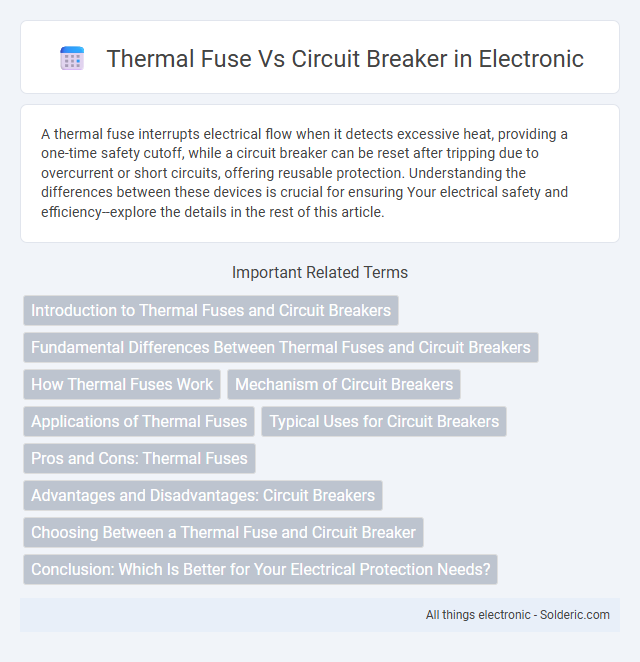A thermal fuse interrupts electrical flow when it detects excessive heat, providing a one-time safety cutoff, while a circuit breaker can be reset after tripping due to overcurrent or short circuits, offering reusable protection. Understanding the differences between these devices is crucial for ensuring Your electrical safety and efficiency--explore the details in the rest of this article.
Comparison Table
| Feature | Thermal Fuse | Circuit Breaker |
|---|---|---|
| Function | Protects against overheating by breaking the circuit when temperature exceeds a threshold | Protects electrical circuits by interrupting current during overloads or short circuits |
| Operation | One-time use; must be replaced after activation | Reusable; can be reset after tripping |
| Reset | No; replacement required | Yes; manually or automatically resettable |
| Protection Type | Thermal protection only | Overcurrent and short circuit protection |
| Response Time | Slower; responds to gradual temperature rise | Faster; responds immediately to electrical faults |
| Typical Application | Appliances, motors, heating elements | Residential, commercial, industrial electrical panels |
| Cost | Lower initial cost | Higher cost due to complexity and reset capability |
Introduction to Thermal Fuses and Circuit Breakers
Thermal fuses and circuit breakers are critical components in electrical safety systems, designed to prevent overheating and electrical fires. A thermal fuse interrupts the circuit when a specific temperature threshold is exceeded, providing a one-time protection mechanism, whereas a circuit breaker automatically trips to cut off the electrical flow during overload or short circuits and can be reset for reuse. Understanding the differences between these devices helps you choose the appropriate protection for your electrical systems.
Fundamental Differences Between Thermal Fuses and Circuit Breakers
Thermal fuses and circuit breakers both protect electrical circuits but operate on fundamentally different principles. Thermal fuses rely on a temperature-sensitive element that permanently disconnects the circuit when a specific temperature threshold is exceeded, providing one-time protection. Circuit breakers use electromagnetic or thermal-magnetic mechanisms to interrupt current flow during overloads or short circuits and can be reset after tripping, offering reusable protection.
How Thermal Fuses Work
Thermal fuses operate by detecting excessive heat generated from electrical overloads or short circuits, causing a temperature-sensitive element to melt and permanently break the circuit. Unlike circuit breakers, which can be reset after tripping, thermal fuses provide a one-time protection mechanism that must be replaced once triggered. Understanding how your thermal fuse works helps ensure efficient protection against overheating and potential fire hazards in electrical appliances.
Mechanism of Circuit Breakers
Circuit breakers operate through an electromagnetic or thermal mechanism that detects excessive current flow and automatically interrupts the circuit to prevent damage. The electromagnetic mechanism uses a solenoid coil to trip the breaker instantly during short circuits, while the thermal mechanism relies on a bimetallic strip that bends when heated by overload currents, causing the switch to trip. This dual-action design ensures efficient protection against both short circuits and prolonged overloads, distinguishing circuit breakers from thermal fuses which operate solely based on heat-triggered melting elements.
Applications of Thermal Fuses
Thermal fuses are primarily used in household appliances such as coffee makers, hair dryers, and refrigerators to prevent overheating by breaking the circuit when a specific temperature is exceeded. Unlike circuit breakers, which protect against overcurrent and short circuits in electrical panels, thermal fuses provide targeted thermal protection in compact, sensitive electronic devices. Your safety is enhanced by thermal fuses in applications where precise temperature control is crucial to avoid fire hazards and equipment damage.
Typical Uses for Circuit Breakers
Circuit breakers are typically used in residential, commercial, and industrial electrical systems to protect wiring and equipment from overcurrent and short circuits. They are designed for repetitive use and can be reset after tripping, maintaining continuous protection for your electrical panels. Common applications include safeguarding lighting circuits, appliances, HVAC systems, and machinery control panels.
Pros and Cons: Thermal Fuses
Thermal fuses provide reliable, one-time protection by permanently shutting off electrical current when a specific temperature is exceeded, preventing overheating and potential fires. Their simplicity and low cost make them ideal for compact, single-use applications, but they require replacement after activation and do not offer reset capabilities like circuit breakers. However, thermal fuses lack flexibility in handling various fault conditions and cannot protect against electrical overloads beyond temperature thresholds.
Advantages and Disadvantages: Circuit Breakers
Circuit breakers offer the advantage of easy reset after tripping, enabling quick restoration of power without replacement, which contrasts with thermal fuses that must be replaced once blown. They provide reliable protection against both overloads and short circuits, enhancing electrical safety in residential and industrial applications. However, circuit breakers tend to be more expensive and bulky compared to thermal fuses, potentially increasing installation costs and space requirements for Your electrical system.
Choosing Between a Thermal Fuse and Circuit Breaker
Choosing between a thermal fuse and a circuit breaker depends on the specific protection requirements of your electrical system. A thermal fuse provides one-time protection by breaking the circuit when temperatures exceed a set limit, ideal for preventing overheating in appliances. Circuit breakers offer reusable protection by detecting overloads or short circuits and can be reset, making them suitable for broader electrical system applications.
Conclusion: Which Is Better for Your Electrical Protection Needs?
Thermal fuses offer precise protection by breaking circuits during overheating, ideal for low-current applications needing quick response to thermal faults. Circuit breakers provide versatile, resettable protection against overloads and short circuits, suitable for broader electrical systems requiring frequent use and maintenance. Choosing between them depends on your specific electrical system's current rating, reset preferences, and fault types to ensure optimal safety and reliability.
thermal fuse vs circuit breaker Infographic

 solderic.com
solderic.com